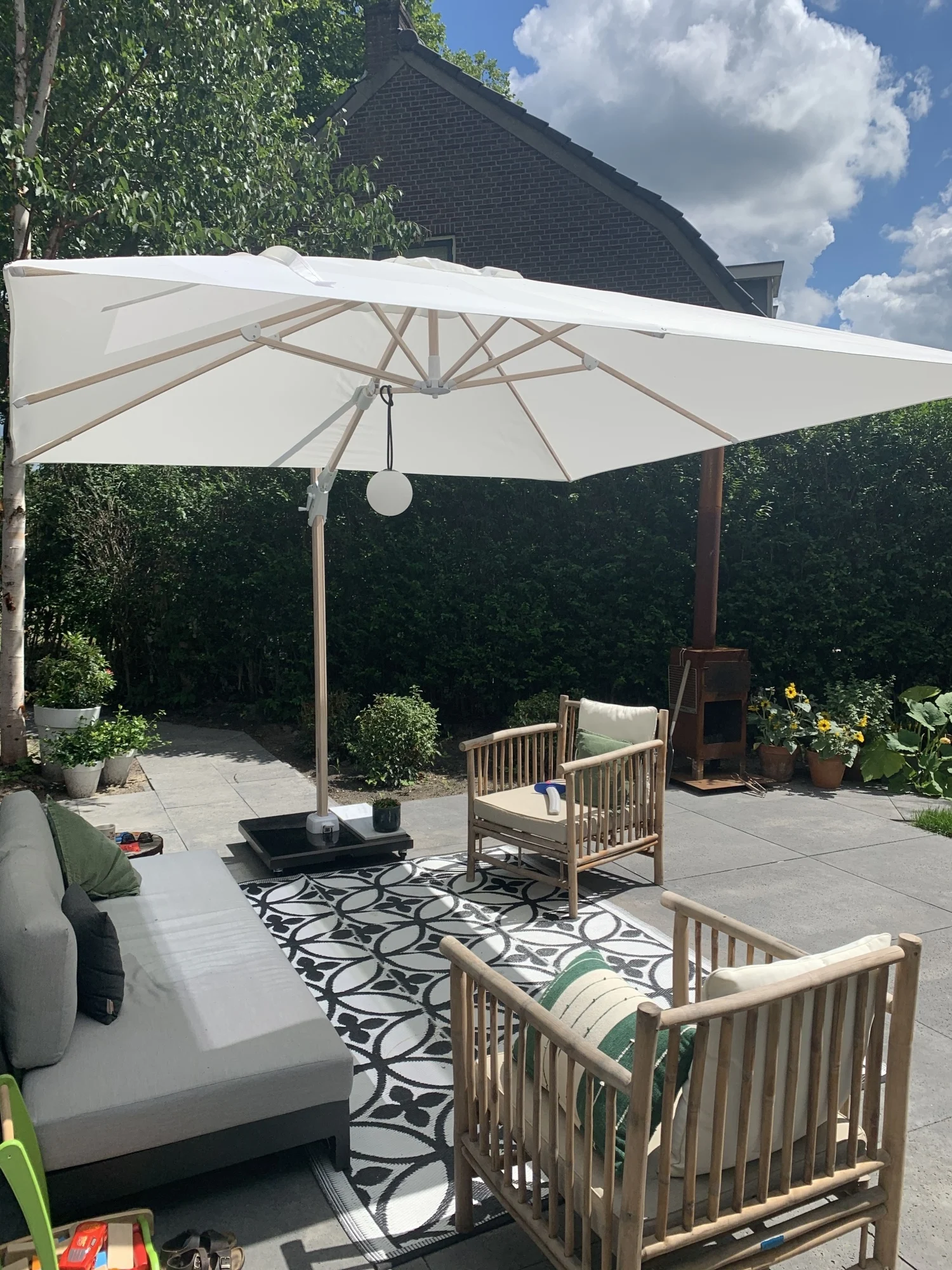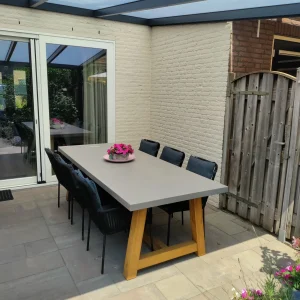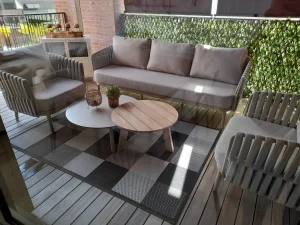Een tuin, doordrenkt van zonlicht, kan een betoverende plek zijn. De warme stralen omhelzen bloemen, planten en paden, waardoor een aura van vitaliteit en kleur ontstaat. Maar naast deze overvloedige zonnestralen, is er een andere speler in het spel – schaduw. Schaduw, in al zijn diversiteit, voegt een geheel nieuwe dimensie toe aan de tuinervaring. Van verkoelende oases tot subtiele texturen en uitdagende ontwerpoverwegingen, schaduw is een onmisbare en veelzijdige kracht in de tuin.
We kunnen dus wel stellen dat iedere tuin een vorm van schaduw nodig heeft. Gelukkig zijn er dan ook heel erg veel verschillende soorten en vormen van schaduw en het is dan ook prettig om daarop in te spelen. Op die manier zie je dan ook dat je met schaduw heel erg veel kan bereiken in je tuin. Schaduw draagt dan ook echt bij aan het comfort dat je in je tuin kan ervaren en juist dat is dan ook heel erg belangrijk voor veel mensen.
Kijk dan ook goed naar manieren om schaduw te realiseren en kijk daarbij vooral ook goed naar welke manieren het beste bij jouw tuin passen. Op die wijze zie je al snel dat je het hele plaatje compleet kan maken en dat je daar dan ook je voordeel mee kan doen
De esthetische waarde van schaduw
In de tuin fungeert schaduw als een kunstenaar, die speelt met licht en donker om een meeslepend tableau te creëren. Onder de koelte van de schaduw gedijen planten met verschillende tinten groen, terwijl bloemen hun kleurenpracht behouden zonder te vervagen onder de verzengende zon. De contrasten tussen licht en schaduw voegen diepte toe aan het landschap, waardoor het visueel boeiend en dynamisch wordt.
Bovendien biedt schaduw een podium voor tuiniers om te experimenteren met verschillende plantensoorten. Schaduwminnende planten zoals varens, hosta’s en vingerhoedskruid gedijen in gebieden waar direct zonlicht schaars is. De gedempte lichtomstandigheden onthullen vaak subtiele details die anders verloren zouden gaan in de felle zon. Schaduw creëert dus niet alleen een visueel aantrekkelijk landschap, maar opent ook de deur naar een breed scala aan plantenkeuzes en ontwerpmogelijkheden.
Voor veel mensen is dit dus ook belangrijk van waarde. Want het oog wil immers ook wat en op deze wijze realiseer je dus ook nog eens een prachtig plaatje in je tuin
De ecologische impact
Naast zijn esthetische waarde speelt schaduw een cruciale rol in het ecologische evenwicht van de tuin. Het biedt een toevluchtsoord voor talloze dieren, van insecten tot vogels en kleine zoogdieren. Onder de beschutting van bomen en struiken vinden deze wezens bescherming tegen roofdieren en extreme weersomstandigheden. Bovendien bevorderen schaduwrijke gebieden biodiversiteit door een gevarieerd habitat te bieden dat verschillende soorten flora en fauna ondersteunt.
Daarnaast heeft schaduw een aanzienlijke invloed op de temperatuur van de tuin. In de hitte van de zomer fungeert schaduw als een natuurlijke airconditioning, waardoor de temperatuur wordt verlaagd en de verdamping wordt verminderd. Dit heeft niet alleen voordelen voor de planten, maar ook voor de tuiniers die verlichting zoeken van de verzengende hitte. Bovendien vermindert schaduw de behoefte aan water, omdat planten in de schaduw minder snel uitdrogen dan hun zonovergoten tegenhangers, waardoor de tuin een duurzamere en waterbesparende omgeving wordt.
Veel mensen vinden het heel erg belangrijk om deze ecologische impact te maken en dat is het natuurlijk om heel veel verschillende redenen ook. Het is dan ook belangrijk om goed te kijken welke manieren je hiervoor kan vinden en hoe je dan ook zorgt voor deze impact.
Kijk hierbij vooral ook goed naar de mogelijkheden in je eigen tuin juist dit is heel erg belangrijk om mee te nemen en om voldoende aandacht aan te schenken onderaan de streep.
Ook praktische overwegingen spelen een rol
Naast zijn esthetische en ecologische waarde brengt schaduw ook praktische overwegingen met zich mee voor tuiniers. Bij het plannen van een tuinontwerp is het essentieel om rekening te houden met de beweging van de zon en de resulterende schaduwpatronen. Dit omvat het identificeren van gebieden die voortdurend in de schaduw liggen, evenals zones die afwisselend zonlicht ontvangen gedurende de dag.
Het begrijpen van deze schaduwpatronen stelt tuiniers in staat om planten zorgvuldig te selecteren op basis van hun lichtbehoeften. Zo kunnen zonneaanbiddende planten zoals tomaten en paprika’s worden geplaatst in gebieden met maximale zonblootstelling, terwijl schaduwminnende gewassen zoals sla en spinazie gedijen in koelere, schaduwrijke hoeken. Door deze zorgvuldige planning kunnen tuiniers de productiviteit van hun tuin maximaliseren en tegelijkertijd de behoefte aan kunstmatige irrigatie verminderen.
Bovendien kan schaduw strategisch worden gebruikt om de leefbaarheid van buitenruimtes te verbeteren. Het creëren van schaduwrijke plekken met behulp van pergola’s, luifels of bomen biedt een aangename omgeving om te ontspannen en te genieten van de natuur, zelfs op de warmste dagen. Deze schaduwrijke toevluchtsoorden worden vaak het middelpunt van de tuin, waar vrienden en familie samenkomen om te delen in de vreugde van het buitenleven.
Wees je hier dan ook goed bewust van en kijk ook goed wat schaduw ook in deze vorm voor jou en je tuin betekenen kan. Hierbij zie je dan ook dat schaduw de overhand kan nemen en dat wil je liever niet. Juist om de balans te realiseren in je tuin moet je hier dus heel bewust mee om gaan onderaan de streep.
Met genoegen! Laten we dieper ingaan op enkele aspecten van schaduw in de tuin, zoals de verschillende soorten schaduw, de invloed ervan op plantengroei en het creëren van schaduwrijke tuinontwerpen.
De keuze uit verschillende soorten schaduw
Schaduw in de tuin kan variëren in intensiteit, duur en oorsprong. Hier zijn enkele veelvoorkomende soorten schaduw:
Dit type schaduw treedt op wanneer een object, zoals een gebouw of een boom, direct tussen de zon en het oppervlak staat dat wordt overschaduwd. Directe schaduw is meestal het meest intens en kan gedurende de dag van positie veranderen, afhankelijk van de beweging van de zon.
Ook wel diffuus licht genoemd, indirecte schaduw ontstaat wanneer zonlicht wordt verstrooid door wolken, mist of andere objecten voordat het de grond bereikt. Deze vorm van schaduw is zachter en minder intens dan directe schaduw, en kan een meer gelijkmatige verlichting bieden aan planten gedurende de dag.
Gebieden die gedeeltelijk worden blootgesteld aan direct zonlicht en gedeeltelijk aan schaduw worden beschouwd als gedeeltelijke schaduwgebieden. Deze zones kunnen variëren in intensiteit afhankelijk van de tijd van de dag en de positie van de zon, waardoor ze geschikt zijn voor een breed scala aan planten die zowel zonlicht als schaduw verdragen.
Diepe schaduw wordt gevonden onder dichte, weelderige vegetatie of in de buurt van hoge structuren waar direct zonlicht nauwelijks doordringt. Planten die gedijen in diepe schaduw hebben specifieke aanpassingen ontwikkeld om te overleven met minimale blootstelling aan licht.
De invloed van schaduw op de groei van planten
Schaduw heeft een aanzienlijke invloed op de groei en ontwikkeling van planten. Terwijl sommige planten gedijen in de koelte van schaduwrijke omgevingen, kunnen anderen een overvloed aan zonlicht vereisen om goed te gedijen. Hier zijn enkele manieren waarop schaduw plantengroei beïnvloedt. En deze manieren wil je natuurlijk goed kennen zodat je hier rekening mee kan houden in je tuin. Juist doordat er verschillende soorten manieren zijn moet je hier ook goed mee omgaan en zorg je er daarnaast voor dat alles klopt.
Planten in de schaduw ervaren verminderde fotosynthese omdat ze minder toegang hebben tot licht, wat resulteert in langzamere groei en mogelijk kleinere bladeren.
Planten in de schaduw hebben over het algemeen minder water nodig dan planten in de volle zon, omdat ze minder water verdampen door transpiratie.
In dichte vegetatie concurreren planten om toegang tot licht. Dit kan leiden tot het strekken van planten op zoek naar licht, wat resulteert in zwakkere stengels en een minder compacte groeiwijze.
Planten in de schaduw vertonen vaak diepere groene kleuren en hebben een zachtere, meer weelderige textuur in vergelijking met hun zonne-aanbiddende tegenhangers.
De meest schaduwrijke tuinontwerpen
Bij het ontwerpen van een tuin is het belangrijk om rekening te houden met de plaatsing en het gebruik van schaduw. Hier zijn enkele strategieën voor het creëren van schaduwrijke tuinontwerpen. Kijk goed of deze ook toe te passen zijn bij jou in de tuin en of jij er dan ook op die manier je voordeel mee kan doen onderaan de streep.
Plant grote bomen en struiken op strategische locaties om schaduw te werpen op delen van de tuin die koelte nodig hebben. Kies soorten die goed gedijen in de lokale omstandigheden en die passen bij de schaal van de ruimte. Als je dit namelijk goed aanpakt dan merk je al snel dat alles klopt. Je kan hier dan ook een heel fijn klimaat mee realiseren en juist dat is dan ook belangrijk onderaan de streep.
Installeer pergola’s, luifels of schaduwdoeken boven terrassen, patio’s en zithoeken om beschutting te bieden tegen de zon. Dit creëert comfortabele buitenruimtes waar mensen kunnen ontspannen en vermaken, zelfs op de warmste dagen. Dit vinden veel mensen erg prettig en dat is het natuurlijk ook. Het is dan ook hierbij weer belangrijk dat je hier voldoende aandacht aan besteed en dat je er dan ook op die wijze voor zorgt dat alles klopt.
Overweeg het creëren van speciale schaduwtuinen met planten die gedijen in lage lichtomstandigheden. Combineer verschillende soorten schaduwminnende planten om een weelderige en interessante omgeving te creëren die het hele seizoen door bloeit.
Integreer water elementen zoals fonteinen, vijvers of beken in de tuin om natuurlijke koeling te bieden en een gevoel van rust en sereniteit te bevorderen. Het geluid van kabbelend water kan een rustgevend contrast vormen met het zachte ruisen van de bladeren in de wind.
Door bewust om te gaan met schaduw in het tuinontwerp kunnen tuiniers een harmonieuze en uitnodigende buitenruimte creëren die zowel functioneel als esthetisch aantrekkelijk is. Schaduw is niet alleen een praktisch aspect van de tuin, maar ook een creatieve kracht die de mogelijkheid biedt om een unieke en persoonlijke buitenomgeving te creëren.
Schaduw is meer dan alleen de afwezigheid van licht; het is een essentieel en veelzijdig element in de tuin. Van zijn esthetische waarde en ecologische impact tot zijn praktische toepassingen, schaduw speelt een centrale rol in het vormgeven van de tuinervaring. Als tuiniers streven we er voortdurend naar om harmonie te vinden tussen licht en schaduw, waardoor we een weelderig en uitnodigend landschap creëren dat zowel de zintuigen prikkelt als de natuur ondersteunt.
Iedere tuin heeft schaduw nodig
Zoals je wel kan zien zijn er heel erg veel verschillende soorten tuinen en iedere tuin heeft dan ook schaduw nodig. Dat is een gegeven. Het is dan ook belangrijk om goed te kijken naar hoe je dit kan realiseren en hoe je kan zorgen dat deze schaduw ook realiteit kan worden bij jou in de tuin.
Gelukkig zijn hier veel verschillende manieren voor en hebben we je in deze blog ook aardig wat van deze manieren laten zien zodat je hiermee zelf ook goed uit de voeten kan onderaan de streep.
Iedere tuin heeft dus schaduw nodig en het is dan ook per tuin verschillend hoe je dit vorm kan gaan geven en wat je dus actief kan doen om deze schaduw te realiseren zodat ook jij optimaal van je tuin kan gaan genieten.
Kijk goed naar welke optie jij dan ook een plekje in je tuin gaat geven. Denk aan een parasol, schaduwdoek of een zonnescherm. Maar ook kun je natuurlijk heel erg goed met verschillende soorten beplanting werken en ook dat is natuurlijk echt een feestje onderaan de streep.
Kijk dan ook goed naar welke wijze het beste bij jou en je tuin past en doe daar dan ook je voordeel mee en maak zo het plaatje helemaal compleet.











